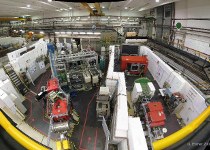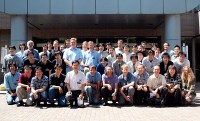 |
|
|
 |
Polarimeter on the electron stretcher
Detector prototype proves itself in the testbeam

View of the experimental hall at Bonn University's electron stretcher facility. The polarimeter is in the area on the right. |
Most collaborations who test their detector prototypes in a test beam want a well-defined stream of single particles into their setup so that they can test their equipment, alignment and software in order to cross-check it against the particle beam. Others want their setup bombarded to see whether it works – for example, the team around DESY’s Jenny List, who design and build so-called polarimeters that measure the combined spin of the beams of electrons and positrons as they pass through before and after they have collided. (Read the info box for a more detailed description of a polarimeter or follow the link to learn more about polarisation.)
Read more...
-- Barbara Warmbein
What is a polarimeter?
A polarimeter measures the combined spins (polarisation) of particles in a particle bunch, by using the effect that photons from a laser beam can knock single electrons out of a particle bunch. These 'Compton-scattered' electrons are sent through a magnetic chicane where they are deflected. The degree of deflection depends on their energy which, in turn, depends on its own polarisation. Behind the chicane, the electrons are sent through gas-filled tubes with mirrors on the inside. Flying through the tubes, they emit a blue light – Cherenkov radiation – which is directed at the end of the tube by the inside mirror surface. A photo detector measures the amount of light that comes through.
Read more about polarisation
|
 |
|
|
 |
Upcoming meetings, conferences, workshops
Lepton Photon 09
Hamburg, Germany
17-22 August 2009
14th International Conference on RF Superconductivity (SRF2009)
Berlin, Germany
20-25 September 2009
2009 Linear Collider Workshop of the Americas (ALCPG09)
The University of New Mexico, Albuquerque, New Mexico, USA
29 September - 3 October 2009
Upcoming schools
International School of Physics "Enrico Fermi" (SIF)
Radiation and particle detectors
Varenna, Villa Monastero, Italy
20-25 July
Linear Collider Physics School 2009
Ambleside, England
17-23 August 2009
Fourth International Accelerator School for Linear Colliders
Beijing, China
7-18 September 2009
|
|
|
GDE Meetings calendar
View complete ILC calendar
|
|
|
 |
Cross-field collaboration on photon detectors

PD09 participants gather for a group photo just outside the conference room on Shishu University's campus. |
Just a 15-minute walk from Matsumoto Castle in Nagano prefecture, which is considered a national treasure of Japan, you’ll find Shinshu University, where the International Conference on Photon Detectors, or PD09, was held from 24 to 26 June. The conference was attended by 55 photon-sensor experts in the field of high-energy physics, nuclear physics, cosmic-ray physics and medical science, along with three companies—Hamamatsu, SEIKO EG&G and General Electric—to discuss the recent development of photon-sensors and various applications. In 2007, both the ILC and the T2K neutrino experiment project groups initiated this bi-yearly conference in Kobe to collaborate on the use of the multi-pixel photon counter (MPPC) and other newly developed photon-sensors.
Read more...
-- Misato Hayashida |
 |
|
|
 |
From CERN
1 July 2009
Grids Step-up to a Set of New Records: Scale Testing for the Experiment Programme '09 (STEP'09)
After months of preparation and two intensive weeks of 24 x 7 operation the LHC experiments are celebrating the achievement of a new set of goals aimed at demonstrating full readiness for the LHC data taking run expected to start later this year.
Read more... |
|
From SLAC Today
30 June 2009
Researchers Find Evidence for the Origin of Cosmic Rays
An international team of researchers has discovered strong evidence that extremely energetic cosmic rays are born in supernova remnants.
Read more... |
|
From Popsci.com
30 June 2009
Berkeley Lab Builds a Desktop Particle Accelerator
The BELLA accelerator uses synchronized lasers to speed up electrons over very short distances. But whereas the Stanford Linear Accelerator (SLA) is 2 miles long, BELLA fits in a single room.
Read more... |
|
From Fermilab
29 June 2009
Fermilab's CDF observes Omega-sub-b baryon
At a recent physics seminar at the Department of Energy’s Fermi National Accelerator Laboratory, Fermilab physicist Pat Lukens of the CDF experiment announced the observation of a new particle, the Omega-sub-b (Ωb).
Read more... |
|
From Spiegel online
25 June 2009
DER SPIEGEL VOR 50 JAHREN (27/1959): Wettkampf der Atomschleudern
Read more... (in German) |
|
From Physics World
25 June 2009
UK physics hit by new cuts
One of the UK's leading research councils has announced today that it is to slash funding for a number of key national facilities.
Read more... |
|
From Nature
24 June 2009
Science journalism: Breaking the convention
Blogs and Twitter are opening up meetings to those not actually there.
Read more... |
|
From euroalert.net
24 June 2009
EC and CERN sign a Memorandum of Understanding for cooperation
Read more... |
|
|
 |
“A picture is worth a thousand words”– (sometimes attributed
to) Napoléon Bonaparte

Jean-Pierre Delahaye |
Today, in less than 1000 words, I announce the addition of a new member of the Global Design Effort Executive Committee (EC), Jean-Pierre Delahaye of CERN. Jean-Pierre will allow us to form stronger ties with CERN, as well as a direct connection with the Compact Linear Collider Study (CLIC) initiative. CLIC is an alternative approach towards a linear collider that could potentially achieve higher energies, but on a longer time scale. Delahaye is a prominent accelerator scientist, who has been an active member of the GDE since the development of the Reference Design Report (RDR) and he has served as Deputy European Regional Director to Brian Foster.
Read more...
-- Barry Barish
Director's Corner Archive |
 |
|
|
 |
Register for the Linear Collider Physics School
 This year's Linear Collider Physics School will bring together students and researchers from around the world to learn about accelerators, detectors and its physics potential and to also discuss their research with world-leading experts. The number of places has been extended and financial support is still available.
This year's Linear Collider Physics School will bring together students and researchers from around the world to learn about accelerators, detectors and its physics potential and to also discuss their research with world-leading experts. The number of places has been extended and financial support is still available.
arXiv preprints
0906.5508
Chargino and Neutralino Separation with the ILD Experiment
0906.5471
Use of transverse beam polarization to probe anomalous VVH interactions at a Linear Collider
0906.4632
Supersymmetry
|
|

